Key Points
- What Does Sustainable Pet Food Packaging Mean
- Why Sustainable Pet Food Packaging Matters
- The Barriers to Sustainable Pet Food Packaging
- A Step by Step Guide to Creating More Sustainable Pet Food Packaging
Article Summary
Sustainable pet food packaging is a challenge—it has to maintain freshness and function while also reducing a brand’s impact on the environment. It isn’t always easy to walk this balance—but with the right holistic approach, brands can learn how to shift to sustainable pet food packaging design.
What Does Sustainable Pet Food Packaging Mean?
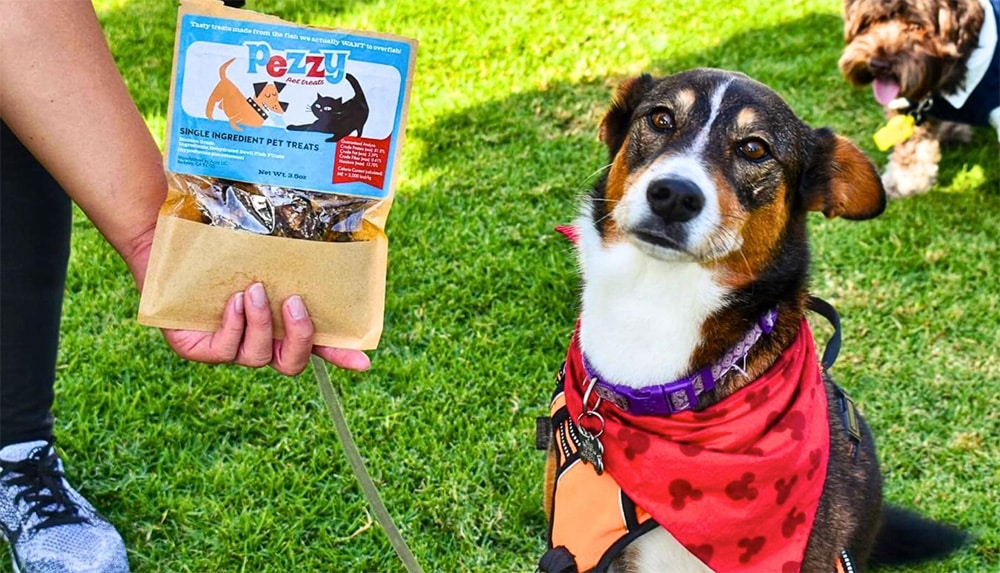
Image courtesy of Pezzy.
In the packaging world, sustainability is a hot topic. But what exactly does “sustainable packaging” mean?
One of the key benefits of sustainable pet food packaging is reducing environmental impact while supporting animal welfare and ethical practices.
Fundamentally, sustainability is about preserving the planet’s resources for future generations—and being aware of how our actions impact the environment. For pet food packaging to be truly sustainable, it would need to have a net neutral or net positive for the environment.
The Sustainable Packaging Coalition’s list of criteria includes packaging that:
- Is beneficial, safe, and healthy for people and communities
- Is sourced, produced, and transported using renewable energy
- Is designed to optimize materials and energy use
- Maximizes the use of renewable or recycled materials
- Is manufactured using clean, environmentally-conscious technologies
These standards also help protect animals and promote ethical practices in the pet food industry by encouraging responsible sourcing and production.
According to Saloni Doshi, CEO and Chief Sustainability Officer of EcoEnclose, a leading innovator in sustainable packaging supplies, true sustainable packaging doesn’t exist yet—all packaging still has a net negative impact on the environment. But that doesn’t mean we can’t take steps toward more eco-friendly choices.
On an episode of our podcast, Entrepreneur Minds Speak, Saloni emphasized the importance of looking at the big picture when it comes to sustainable packaging. It’s not just about replacing plastic with another material; it’s about assessing the full lifecycle of the packaging, from sourcing to disposal.
For the pet food industry in particular, truly sustainable packaging is going to be a challenge that requires creative solutions, maintaining freshness, shelf life, and customer convenience. Commercial pet food is a regulated product that must meet strict safety and nutritional standards, and its packaging must also ensure product integrity and compliance. But with the right strategies in place, you can embrace more sustainable options, discover innovative solutions, and position yourself as a sustainability leader in the industry.
In the following sections, we will go into detail about sustainable pet food packaging solutions, including best-in-class standards and practices that set the benchmark for the industry.
Why Is Sustainable Pet Food Packaging Important?
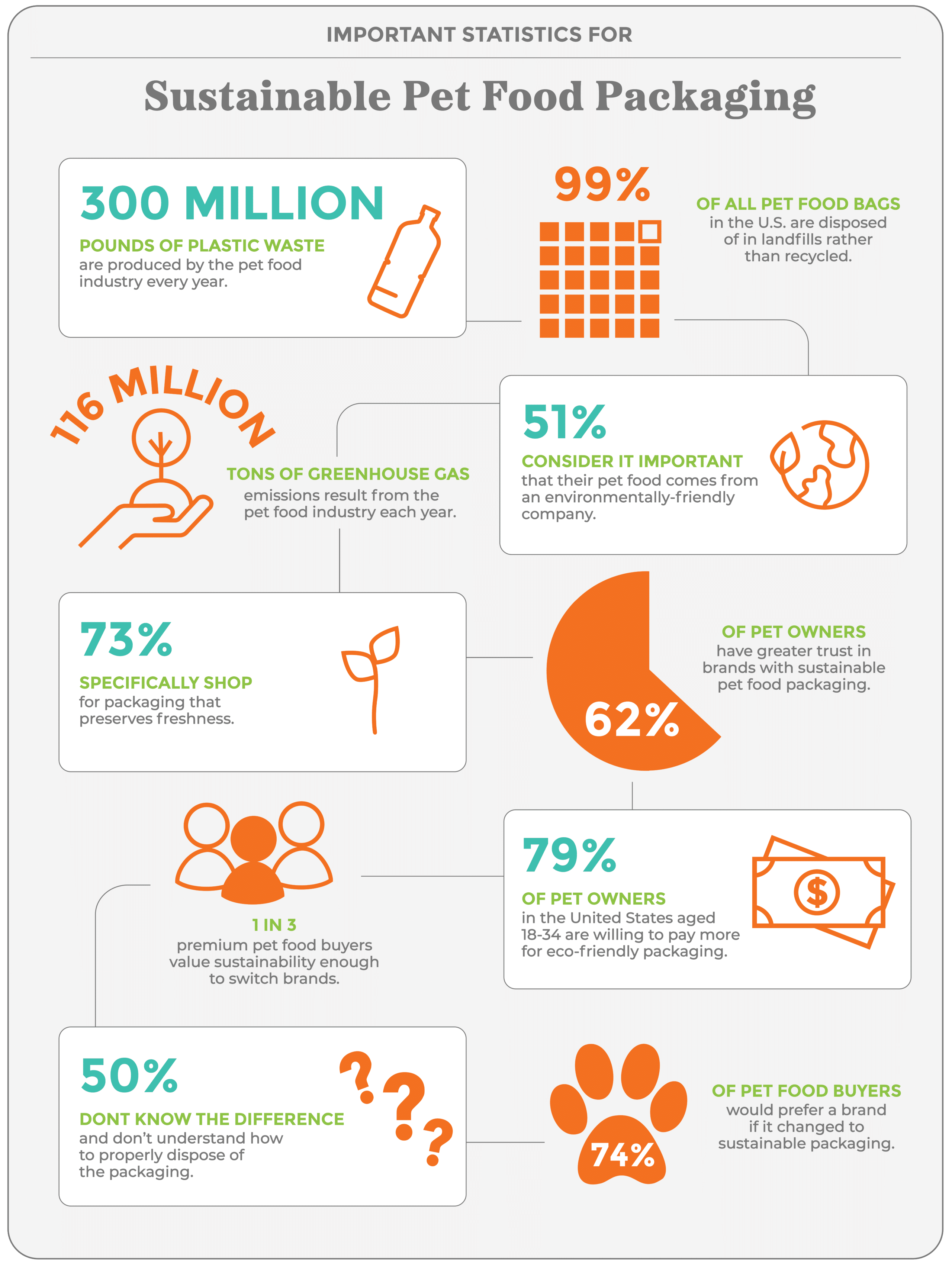
- 300 million pounds of plastic waste are produced by the pet food industry every year
- 99% of all pet food bags in the U.S. are disposed of in landfills rather than recycled.
- 116 million tons of greenhouse gas emissions result from the pet food industry each year
The pet food industry has a large environmental impact, responsible for an estimated 300 million pounds of plastic waste each year—most of which comes from single-use packaging that ends up in landfills. With the number of U.S. households with pets continuing to rise, pet ownership is at an all-time high, and dogs make up a significant portion of the pet population, further increasing demand for pet food and packaging.
Most pet food packaging is made from multi-layered plastic that preserves freshness—but it’s also notoriously difficult to recycle. This means that even well-intentioned consumers often have no choice but to throw the packaging away.
Brands and consumers in the pet food industry are taking notice and wanting to create change. Adopting sustainable pet food packaging isn’t just about responsibility—it’s also a smart business practice.
According to a survey from Mondi, a global leader in sustainable packaging:
- 74% of pet food buyers would prefer a brand if it changed to sustainable packaging
- 62% of pet owners have greater trust in brands with sustainable pet food packaging
- 1 in 3 premium pet food buyers value sustainability enough to switch brands
In fact, pet owners tend to have an even stronger belief in sustainability than non-pet owners. Research shows that pet owners are more likely to have concerns about climate change, pursue “green” activities, reduce plastics, recycle, and care about recycled materials in what they purchase. Concerned pet parents are increasingly driving demand for more sustainable packaging options as they seek to minimize their environmental footprint.
What does this mean? Despite the challenges standing in the way of sustainable pet food packaging, consumer demand is high. Shopping for sustainable pet food packaging allows consumers to make environmentally responsible choices. Brands need to meet consumers where they are by finding functional and practical ways to switch to more sustainable pet food packaging.
Barriers to Sustainable Pet Food Packaging
While the push for sustainable pet food packaging is gaining momentum, there are significant barriers that make the transition challenging, including cost, durability, and convenience. Finding affordable sustainable packaging solutions is crucial for both brands and consumers.
Consumers report caring about the ease of use when it comes to packaging, including opening and reclosing packages, transporting the food, storing it, and pouring it out. Brands can’t overlook these needs in favor of sustainability. This is one of the reasons why virgin plastic (made from raw materials) stays so popular in the industry. Recycled materials are often less durable, leading to easier ripping and tearing. Improving packaging efficiency during production can help overcome some of these barriers by streamlining manufacturing and increasing throughput.
But the biggest barrier to sustainable pet food packaging is freshness. 73% of pet owners specifically shop for packaging that preserves freshness. Pet food must stay fresh and safe for consumption, often over extended periods. Unfortunately, plastic is still the best way to do that.
While other industries often focus on replacing plastic as the first major step toward sustainability, for the pet industry, this isn’t necessarily the case.
Flexible plastic packaging is resistant to temperature changes and protects food from moisture and contamination. Not only is freshness an obvious pet safety concern, but it’s also a sustainability factor itself—pet food packaging isn’t sustainable if it leads to wasted food and unnecessary purchases.
Plastic remains the most practical pet food packaging material, even according to sustainability leaders. That means that the focus on sustainability looks different in the pet food industry than it might in other areas.
Instead of trying to replace plastic altogether, brands might have to get creative when it comes to sustainability, finding ways to reduce their environmental impact without compromising the safety, freshness, or convenience that pet owners expect.
Innovative sustainable packaging solutions are now being developed that do not compromise on quality or freshness, and many of these options avoid the use of harmful materials such as PFAS chemicals, offering safer and more environmentally friendly alternatives.
Materials and Production: Choosing the Right Sustainable Solutions
As the pet food industry faces growing pressure to reduce plastic waste and minimize its environmental impact, the choice of materials and production methods for pet food packaging has never been more important. Brands are increasingly turning to sustainable packaging solutions that not only protect their products but also appeal to eco-conscious pet owners.
One of the most effective ways to reduce plastic waste is by adopting recyclable pet food packaging. Paper-based materials and bioplastics are gaining traction as sustainable alternatives to traditional plastics. These materials can be sourced from renewable raw materials like bamboo, sugarcane, or cornstarch, offering biodegradable options that break down more easily in the environment.
Incorporating recycled content into packaging is another powerful strategy. By using materials that have already been part of the production cycle, companies can help close the loop and support a circular economy. This approach not only reduces the demand for virgin resources but also diverts waste from landfills.
Pet owners and consumers are increasingly seeking out brands that prioritize sustainability in their packaging choices. As a result, companies that explore innovative materials and production methods are better positioned to meet market demand and reduce their overall environmental footprint. By making thoughtful decisions about the materials used in pet food packaging, the industry can take meaningful steps toward a more sustainable future.
Food Packaging Safety: Ensuring Quality and Compliance
When it comes to pet food packaging, safety and quality are non-negotiable. The pet food industry must ensure that every package not only preserves the freshness and integrity of the food but also protects pets and the environment from potential harm. This means adhering to strict regulations and standards, such as those set by the FDA, to guarantee that packaging materials are safe for both pets and people. Packaging materials should meet safety standards suitable for humans, ensuring they are also safe for pets.
Manufacturers are increasingly moving away from packaging that contains harmful chemicals, such as PFAS, which have raised concerns due to their persistence in the environment and potential health risks. Instead, the industry is exploring recyclable packaging options made from safer materials like paper or bioplastics. These alternatives are designed to be non-toxic, durable, and resistant to moisture and grease—key factors in maintaining food quality and safety. Packaging should also keep food safe and be appealing for pets to eat, ensuring it remains palatable and nutritious.
Beyond compliance, companies must also consider the environmental impact of their packaging choices. Reducing plastic waste and choosing materials that are easier to recycle or dispose of responsibly helps protect the planet while building trust with pet owners. By prioritizing both food packaging safety and sustainability, brands can demonstrate their commitment to the well-being of pets, consumers, and the environment.
Pet Health Meets Smart Packaging: Why It Matters
For pet parents, health and nutrition aren’t just priorities—they’re non-negotiable. But the story doesn’t end with what’s inside the bowl. Thoughtful packaging goes beyond protecting the food—it reflects a brand’s commitment to quality, safety, and sustainability.
Eco-conscious packaging options—like recyclable, compostable, or biodegradable materials—help reduce waste, shrink carbon footprints, and ensure pets get premium nutrition without unnecessary exposure to toxins.
Pet parents are more conscious than ever, seeking brands that align with their values and lifestyle. Choosing products with sustainable packaging isn’t just good for the planet—it’s a clear signal that their pet’s health comes first with your brand.
Packaging and the Supply Chain: From Sourcing to Distribution
Sustainability in pet food packaging isn’t just about the final product—it’s a story that begins at the source and continues all the way to the shelf. Every choice along the supply chain—from raw materials to manufacturing to distribution—shapes a brand’s environmental footprint and its reputation for responsibility.
Sustainable packaging isn’t just eco-friendly; it’s strategic. Locally sourced materials can strengthen communities, streamlined production reduces waste, and thoughtful supplier partnerships ensure ethical, high-quality practices. Even transportation becomes an opportunity: lighter packaging and smarter shipment consolidation can dramatically cut carbon emissions.
Brands that embed sustainability throughout their supply chain don’t just reduce environmental impact—they connect with consumers who value purpose and integrity. By pairing innovative packaging with responsible sourcing and distribution, forward-thinking pet food brands lead the way toward a healthier planet, happier pets, and a more efficient, conscious industry.
Sustainable Packaging Goals: Setting and Measuring Success
Establishing crystal-clear sustainable packaging goals becomes the cornerstone of a brand’s environmental strategy. They guide decisions, reduce impact, and create a tangible story of responsibility that resonates with today’s eco-conscious pet parents.
Smart goals focus on what really moves the needle: minimizing packaging waste, integrating recyclable or renewable materials, and shrinking the carbon footprint across production and distribution. Success is measured through meaningful metrics—tracking recyclable content, landfill diversion, and reductions in greenhouse gas emissions—so every decision is backed by data, not intention alone.
Regularly reviewing and refining these metrics transforms sustainability from a checklist into a strategic advantage. The result? Brands that protect pets, safeguard the planet, and build credibility with consumers who value authenticity and purpose.
Shifting to Sustainable Pet Food Packaging: A Step-by-Step Guide
So, how can brands strike the balance and shift toward sustainability while still providing freshness and functionality? We’ve laid out the answer step by step:
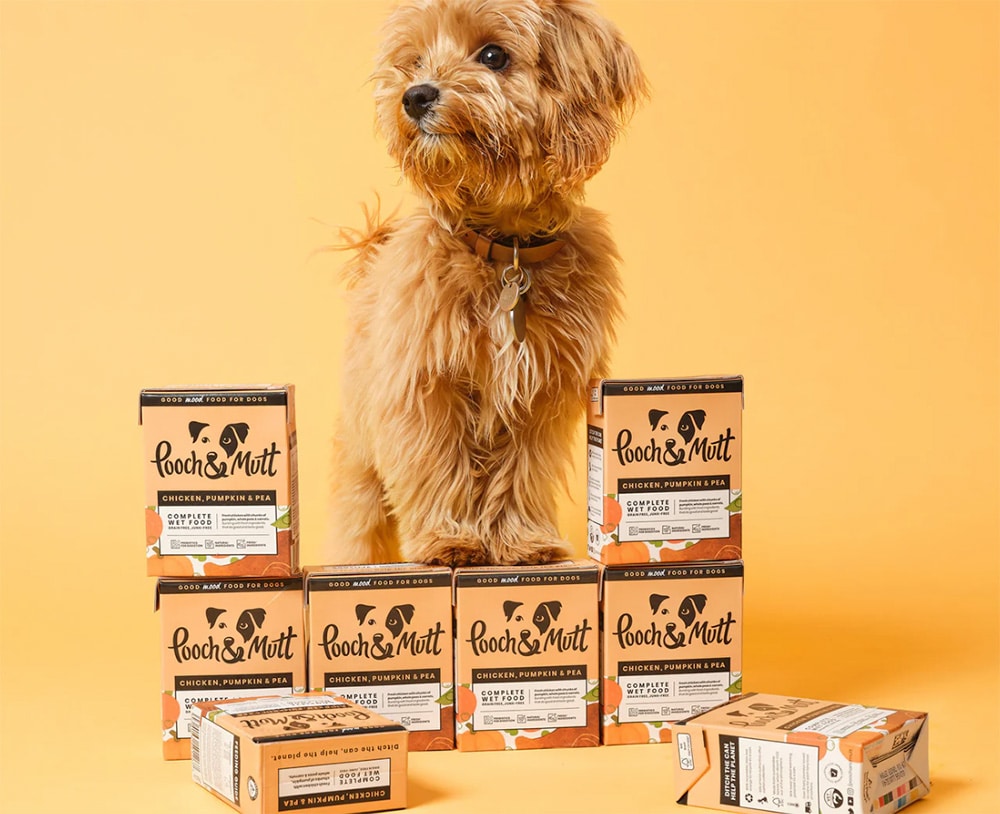
Pooch & Mutt’s wet food comes in 100% recyclable TetraPaks with an easy tear open top. Image courtesy of Pooch & Mutt.
Step 1: Take a Holistic View of Sustainability
Viewing sustainability holistically is important. Environmental impact isn’t just about waste or ocean pollution. Energy, sourcing, and transportation all play a role. Being committed to sustainability means considering every step in the process, from sourcing to end-of-life.
For example, while it might seem more sustainable to switch from plastic to paper, this might not be true—depending on where paper is sourced from, it could lead to deforestation of endangered areas. Metal or glass materials that might be fully recyclable often come with a higher carbon footprint in shipping and transportation.
If we want to work toward sustainable packaging, we need to remember the big picture—especially when it comes to pet food packaging, which isn’t moving away from plastic any time soon.
Since plastic is likely unavoidable, that might mean turning toward innovative options. Hill’s Pet Nutrition recently unveiled new flexible packaging, produced from recycled plastic. Traditional recycled plastic materials are often not food-grade or temperature-resistant—making them unusable in the industry. But this packaging uses advanced recycling technology to create certified-circular polymers—resulting in flexible packaging made largely from recycled materials.
We are seeing more companies co-create innovative and sustainable packaging solutions with their partners, leveraging collaboration to drive progress in the industry.
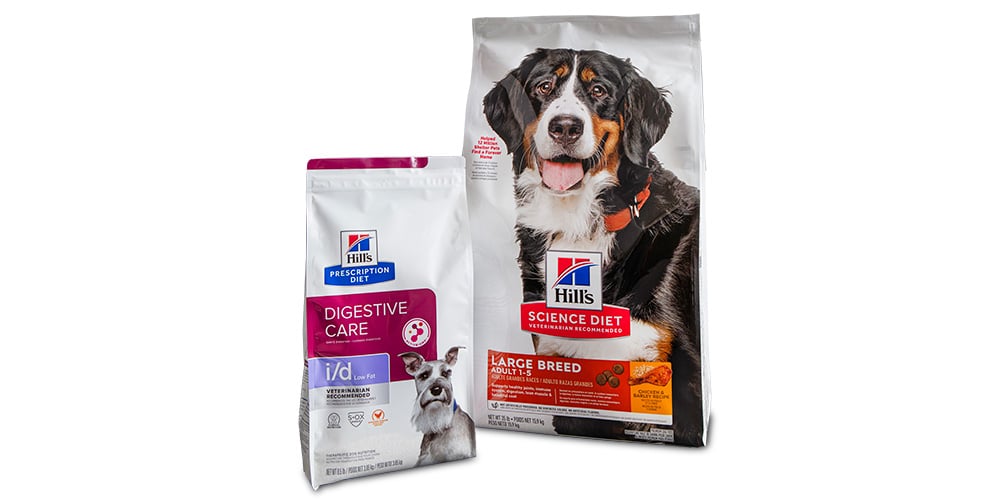
Hill’s packaging, developed by Berry Global and Peel Plastics Products, won the 2024 Gold Award for Sustainability from the Flexible Packaging Association. Image courtesy of Hill’s.
Small startups might not have the budget for cutting-edge solutions or new tech. Instead, they can focus on other areas of sustainability—including switching from synthetic dyes (which result in water waste and can harm marine life) to vegetable-based dyes such as EcoEnclose’s “Algae Black,” which has a net-negative carbon technology (in other words, it actually removes more carbon dioxide in the air than it adds, helping the environment instead of harming it).
Other budget-friendly ways to improve sustainability in pet food packaging might include sourcing locally or working to reduce the carbon footprint from shipping your product.
Remember, your packaging is not sustainable if it’s unaffordable for your business or inaccessible to your customers. Taking a holistic approach to sustainability will help you make decisions that are both environmentally responsible and financially feasible.
Step 2: Keep the Focus on Freshness and Function
Pet safety and product quality must always come first. Regardless of how eco-friendly your packaging may be, if pet owners don’t feel confident in the safety and freshness of the food, they won’t buy it.
Effective sustainable pet food packaging should prioritize freshness and convenience—it must protect food from moisture, air, and light. For example, Earthwise Packaging creates plant-based jars for fish food and freeze-dried pet food. The jars are produced using sugarcane—and they seal nicely to maintain freshness.
Sustainable packaging solutions for dog food and cat food must address the unique needs of each. For dog food, packaging should be durable and easy to handle, while for cats, packaging often needs to accommodate smaller serving sizes and maintain the palatability of the food. Packaging for both should support a variety of foods, including dry food, wet food, and treats, ensuring freshness and safety for both dogs and cats.
For dry pet food, features like reclosable seals are essential, allowing pet owners to store food after opening, maintaining freshness and quality over time.
Packaging for pet treats presents unique challenges, as treats are often used for rewards and bonding, requiring packaging that keeps them fresh, easy to access, and portable. Solutions like resealable pouches or single-serve packs help maintain treat quality while supporting convenience and sustainability.
Packaging must also protect a range of protein sources—such as meat, plant based proteins, insects, and wild caught fish—to maintain the nutritional quality of the food. This is especially important for sustainable food options that use alternative protein sources, as proper packaging supports healthy feeding practices and ensures pets receive balanced nutrition.
Wet pet food is traditionally sold in cans that cannot be resealed—leading to potential waste not just from the package itself but also the product. But some companies are leading the charge to change this. Wet pet food can be packaged in resealable flexible pouches instead of cans.
Alternatively, cans can be sold with reusable lids to keep food fresh after opening. Some brands, such as SmartSolve, are even working to create dissolvable labels for pet food cans, reducing waste even more. (SmartSolve recently joined us on our podcast to discuss the future of dissolvable and disappearing packaging—listen to hear more about this emerging option!)
Remember that progress is what truly counts. Moving toward more sustainable options that still focus on function—even if they aren’t perfect—can reduce your brand’s environmental impact and resonate with eco-conscious consumers.
Step 3: Know Your Audience and What They Want
Switching to sustainable pet food packaging is likely going to require a financial investment. You’re going to need to consider how to maintain your profit margin.
That’s why it’s vital to understand your audience and their priorities. According to surveys, 79% of pet owners in the United States aged 18-34 are willing to pay more for eco-friendly packaging—in fact, most of that group would pay up to 25% more. But only 56% of consumers aged 35-55 are willing to pay more for sustainable pet food packaging—and only 41% of pet owners 55 and up agree.
Buying habits are also influenced by the availability of sustainable packaging options, as consumers may be more likely to purchase products that align with their environmental values.
The location of your consumers also matters. For example, pet owners in the United Kingdom are more likely to prioritize sustainable pet food packaging than in other countries.
A global survey showed that 14% of consumers think companies use sustainability claims as an excuse to charge more—and only 12-16% of this worldwide audience said they would pay more for sustainable pet food packaging.
Understanding your target audience can make a big difference in how you recuperate the costs of sustainability efforts. If your audience is young, you might be able to raise rates higher as you shift to sustainable pet food packaging. But if your audience is older, you might have to tread more lightly and consider other ways to reduce costs.
Step 4: Reduce Unnecessary Packaging
One of the first places any brand can start transitioning to more sustainable pet food packaging is by reducing unnecessary materials.
Right-size packaging, or ensuring that your packaging only uses the amount of material needed for your product, can minimize waste and lower your brand’s transportation carbon footprint—and it can also help you lower costs.
Remember that “right-size” doesn’t necessarily mean bigger or smaller. It’s about finding the most efficient way to package your product. It might be tempting to try to fit more food into each bag—but durability matters (especially if you’re using recycled materials that tear easier).
Streamlining your pet food packaging design, eliminating excess layers, and focusing on minimalistic approaches can contribute to a more sustainable packaging solution.
Step 5: Embrace Reusability
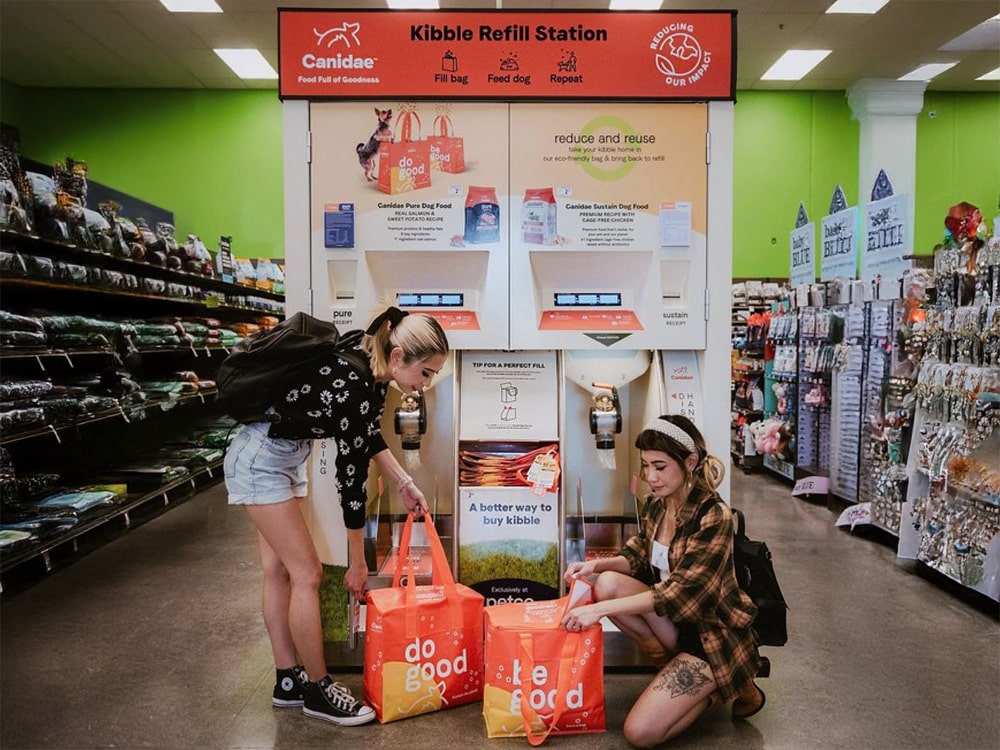
Image courtesy of Canidae.
Reusable packaging might one day be the gold standard for sustainability—allowing packaging to extend its life cycle and reduce waste. However, any reusable solution for pet food has to be carefully considered to prioritize safety. Collaborating with suppliers is essential to develop and support effective reusable packaging systems that meet quality and sustainability standards.
Image courtesy of Canidae.
Canidae partnered with Petco to implement refillable food stations. Customers filled reusable bags with kibble as an alternative to single-use disposable plastic bags. In the first year alone, this eliminated 5,000 bags that would normally end up in landfills.
While this solution might pose an inconvenience to consumers, Canidae was able to offset this with savings. Pet owners saved 45% per pound of food, or $9 per bag, when they chose the refillable option.
This is another way to appeal to your audience—especially if your demographic leans older and is less inclined to pay a premium price for sustainable pet food packaging.
Step 6: Introduce Recyclability Initiatives
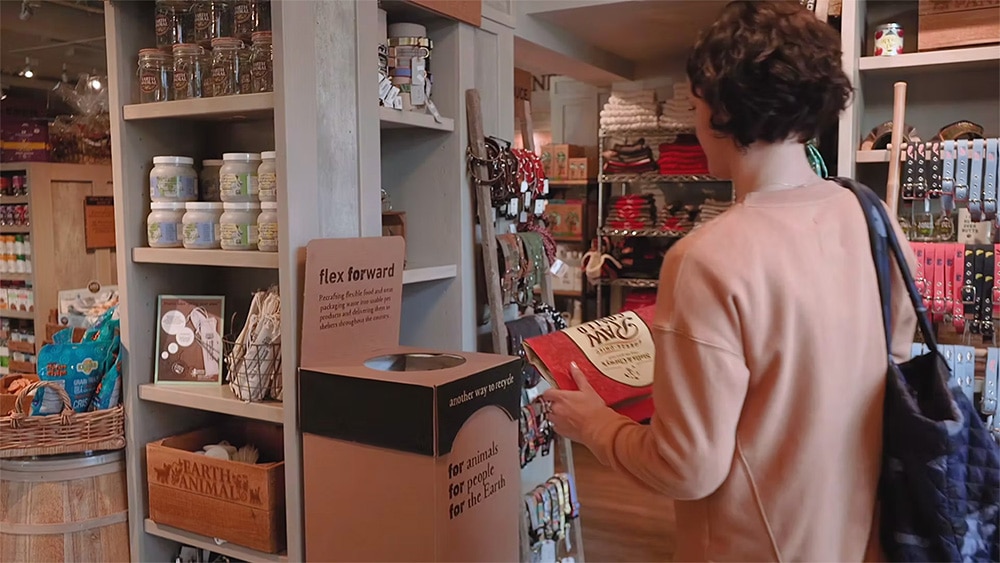
Image courtesy of Flex Forward.
Recyclability is the biggest focus for sustainable pet food packaging. This solution is a win/win for consumers and brands. It reduces landfill waste, preserves freshness, maintains convenience, and could come with a lower cost investment for brands.
Traditional plastic recycling has posed a problem—consumers might not know that plastic can even be recycled, and they have to go out of their way to find a location to take it to. Since flexible plastic typically can’t be recycled curbside, the onus has fallen on consumers to research options and seek out solutions.
Return-for-recycling initiatives aim to address these problems. Brands such as Nature Fresh have partnered with TerraCycle to offer an eco-friendly option for consumers. Pet owners can request prepaid shipping envelopes and mail their packaging in for recycling.
Other initiatives, such as the Flex Forward program through the Pet Sustainability Coalition, encourage customers to bring their used packaging back to the store to be recycled. In the initial three-month rollout trial of Flex Forward, 8,356 pounds of pet food packaging were collected and recycled. Using printable packaging materials also allows brands to clearly communicate recycling instructions directly on the package, making it easier for consumers to understand how to properly recycle.
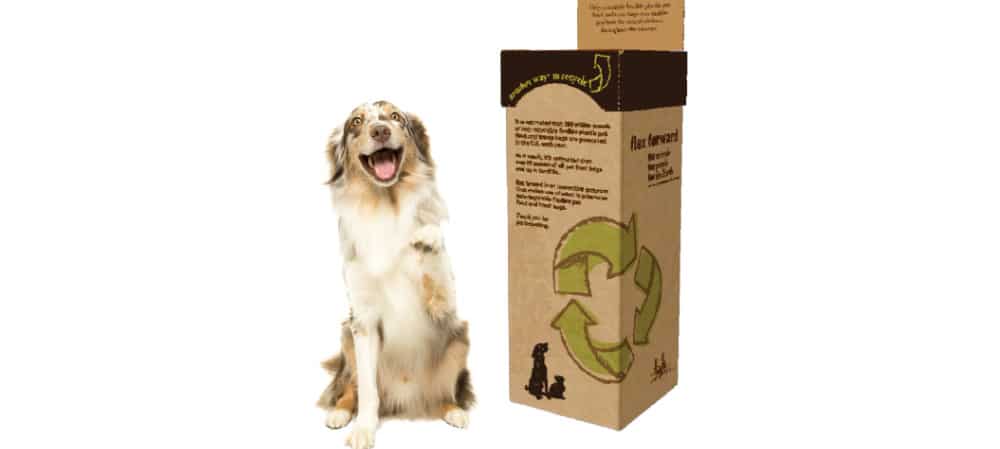
In the Flex Forward program, cashiers were trained to educate consumers on how to clean and return their packaging. Stores that were involved overwhelmingly reported positive feelings about the program and a desire to continue with it. Image courtesy of Flex Program.
These programs do require educating customers. But as they gain traction, they could be a big win for sustainable pet food packaging.
Step 7: Consider Compostable Pet Food Packaging Carefully
Compostable or biodegradable materials could be another option for sustainable pet food packaging. However, this is a complex issue that raises its own set of problems.
While compostable material (made from organic material and typically able to degrade completely in less than 180 days) is a viable sustainable packaging solution, “biodegradable” might not be. Many materials have been advertised as biodegradable, but later turned out to not degrade the way they claimed. The term biodegradable has even been banned in some regions due to the controversy.
But consumers find compostability and biodegradability confusing—about 50% don’t know the difference and don’t understand how to properly dispose of the packaging. Additionally, these materials can require more resources and energy during production, resulting in a more negative overall impact than typical plastic packaging.
Despite the challenges, some companies are actively working on innovative compostable packaging solutions. Grounded and No Issue both produce compostable flexible packaging for pet food and treats.
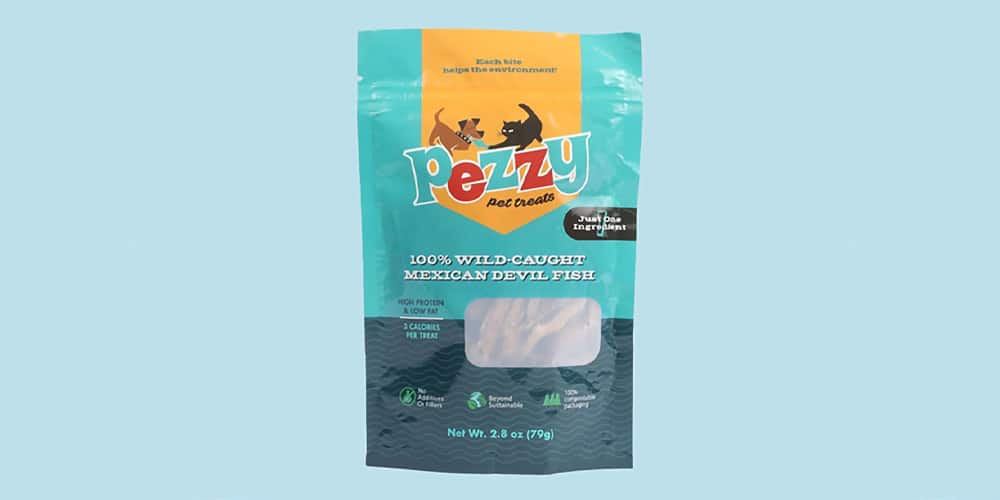
Pezzy’s pet treats are sold in 100% compostable packaging. Image courtesy of Pezzy.
Many sustainable pet food packaging experts recommend focusing on recyclability over compostability—turning to compostable packaging for products that can’t be recycled due to contamination or material type.
Step 8: Offset Your Impact
Pet food packaging might not reach a zero-waste possibility any time soon. But one way brands can still achieve sustainability goals is by focusing on offsetting their environmental impact.
For example, Nature’s Fresh partnered with rePurpose Global for a sustainability initiative. For every pet food package sold, the company collects and removes an equivalent amount of ocean-bound plastic from countries with inadequate waste management infrastructure.
Initiatives like this reduce plastic pollution and appeal to environmentally-conscious consumers who value corporate responsibility and commitments to sustainability.
Step 9: Label Products with Clear Claims
Consumers want to know about sustainable pet food packaging options—and if you don’t label your packaging, they have no way of knowing about your brand’s efforts.
But consumers are also smart, savvy, and skeptical. 51% of pet owners consider it important that their pet food comes from an environmentally-friendly company, but 65% of them are skeptical about sustainability claims made by pet food brands.
It’s vital to avoid “greenwashing,” or claiming your brand is sustainable without actually making an impact. Consumers value transparency—and they have the technology to check on your claims. Apps like Giki Zero allow consumers to scan retail products and see the impact they have on the environment.
A dedicated team plays a crucial role in ensuring transparency and accuracy in sustainability claims, helping to build trust with consumers.
One way to avoid greenwashing and still communicate with your customers about your impact is to label your product with specific and clear claims.
According to research from sustainable packaging leader Mondi, pet food buyers’ purchasing decisions are impacted by specific claims:
- “100% recyclable” (77% of pet owners)
- “Made from 100% recycled materials (75% of pet owners)
- “Made from post-consumer waste” (71% of pet owners)
Avoid vague claims such as “sustainable packaging,” and be authentic and genuine about your product and packaging.
Step 10: Work With an Agency Experienced in Sustainable Packaging
Great sustainable pet food packaging design goes beyond thinking about materials—it also requires understanding branding, how to resonate with customers, and how different material use can impact your designs.
That’s why it’s also important to work with an experienced agency that specializes in sustainable packaging design.
Agencies understand how eco-friendly materials will work together, what kinds of designs will work for different products and brands, and how to communicate your message to consumers.
If you want to explore your options, talk to an experienced agency today about your sustainable packaging needs.
The Future of Sustainable Pet Food Packaging: Trends and Innovations
The future of pet food packaging is bright, with new trends and innovations paving the way for a more sustainable industry. One of the most promising developments is the rise of compostable packaging, which offers a sustainable alternative to traditional plastics and helps reduce plastic waste. Compostable materials, often made from renewable resources, support a circular economy by breaking down naturally and returning nutrients to the soil.
Another exciting trend is the use of plant-based bioplastics and other renewable materials in packaging production. These sustainable solutions not only lower the environmental impact of pet food packaging but also resonate with consumers who are looking for greener options.
Technological advancements are also shaping the future of food packaging. Smart packaging solutions can monitor freshness, temperature, and other factors, ensuring that pet food remains safe and high-quality throughout its shelf life. Digital printing and customizable packaging designs are becoming more popular, allowing brands to create unique, engaging packages that stand out on the shelf and connect with pet owners.
As the pet food industry continues to evolve, companies that embrace these sustainable packaging trends will be better equipped to reduce their environmental impact, build brand loyalty, and meet the growing expectations of eco-conscious consumers. By staying ahead of the curve, brands can help lead the way toward a more sustainable and innovative future for pet food packaging.
Custom Sustainable Packaging Design
If you want to truly establish yourself as an eco-conscious brand, consider custom sustainable packaging design.
As an experienced packaging design agency, Crème de Mint can work with manufacturers to create customized sustainable product packaging that resonates with pet owners, establishes a sense of trust, protects your pet food, and helps you reach sustainability goals.
Contact us today to get started on your sustainable pet food packaging design!
About the Author
Lauren Casgren-Tindall is the founder of Crème de Mint and has been creating powerful, innovative designs over the past 15 years for pet brands such as Lucky Tail and Dr. Carol DVM. She is experienced in sustainable product packaging design and understands how to resonate with consumers through branding.



